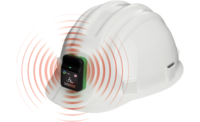"It's just like EZPass," says Celebi about the system, made by ADR Software, Reston, Va. As workers pass through, data from their tags is sent to a database. In this way, managers can know who is on-site, when they entered, their job title and, to track local and minority hire requirements, their zip code and ethnicity.
Data isn't stored on the tag itself; it's just a flag that identifies which worker is walking in. "The tag is just a number," says Scott Kasprowicz, chairman and CEO, ADR. "But we can have a dossier on you in our system as long as 30 Holy Bibles."
ADR's cloud-based service hosts real-time data coming from the jobsite and can be checked from any location with a tablet, a laptop and, soon, an app, says Kasprowicz. "Once the portal is set up, we deliver an 'automated daily report,' which is what ADR stands for." The reports can integrate with Microsoft's Sharepoint Collaboration software; the average system costs less than $2,000 a month to maintain, he says.
"The construction industry is still pretty primitive," says Celebi. It hasn't reached the productivity-monitoring levels of other industries, he adds. But by collecting data from a jobsite, such as the number of carpenters or painters it takes to finish a job, Celebi says productivity can improve. "That info becomes very valuable on the next project," he adds.
The Link to BIM
DPR Construction, San Francisco, also uses RFIDs to secure a 100,000-sq-ft site at San Francisco Bay Hospital. It uses Trimble's ThingMagic RFID system, which integrates into the firm's BIM software. This means worker locations can be tracked using the project's 3D model (">Click here to see a rendering of the system.)
Data about worker location is limited only by the percentage of the site covered by the RFID sensors. On DPR's hospital site, for example, sensors guard site-access turnstiles, elevator banks, staircase landings and man-lift landings among 19 site zones.
"Through the life of the project we'll have four levels of [access] protocol," says Osman Chao, project executive for DPR. The protocol levels denote necessary qualifications and cleanliness requirements for anyone entering a specific zone for the job's requirements. "We don't reach level four until the building is closed, and we're doing interior build-outs."
If a worker does enter an unauthorized zone, the sensors send an email to the supervisor. In case of evacuation, the system provides real-time reports on the 3D model of worker locations, down to zone level.
Saving Minutes
Consolidated Contractors Co. (CCC), Athens, Greece, is using RFIDs to manage the great numbers of workers simultaneously entering the $290-million ethylene plant it is building. The site, 300 kilometers from Dubai in the middle of an unforgiving desert, challenges the hardware.
"You don't understand what sand and heat do to hardware unless you've worked in a real desert," says Firas Hijazi, manager of information systems, project automation and controls for CCC. Half the RFID readers Hijazi installed to speed worker ingress and automate work hours failed within six months at desert temperatures that easily passed 120ºF.
CCC searched for an available system to decrease worker onboarding time and deliver a live worker count to the owner, GASCO, Abu Dhabi, and main contractor JGC Corp. Yokohama, Japan.
"Getting a vendor to work with us at our remote location was another challenge," adds Hijazi, who only had two months to decide upon and implement the technology. "We also needed to read multiple workers passing through at once in a bus."
Hijazi's crew set up fixed readers and antennas on the gates leading into the site to read the workers' RFID tags as they entered on buses. Readers sent data to a back-end database using general packet radio service, or 2G and 3G cellular communication.
With this setup, Hijazi tested passive, active and battery-assisted passive (BAP) RFID tags. Passive tags were the least costly, at $2 to $3 per employee; BAP tags were the next least costly, at $7 per employee.









Post a comment to this article
Report Abusive Comment